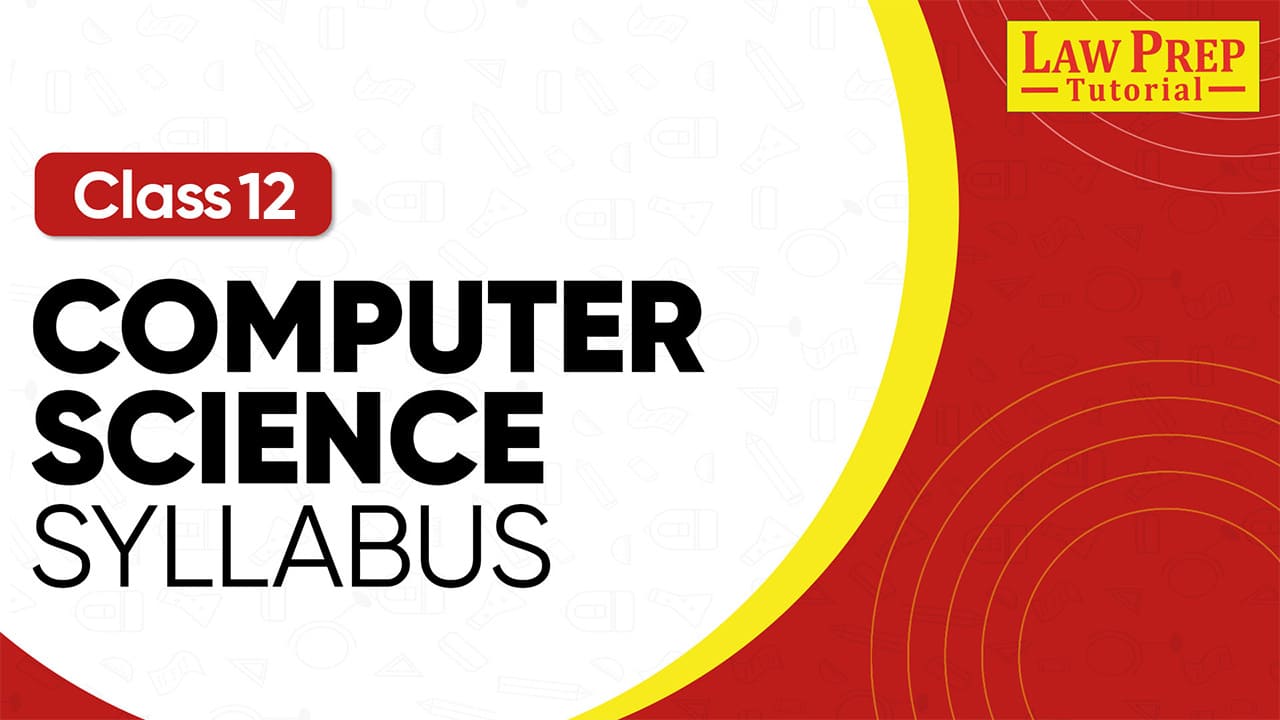The CBSE Class 12th Computer Science syllabus is designed to prepare students with advanced knowledge of programming, data handling, networking, and database management.
It emphasizes Python programming with recursion, file handling, and SQL integration, ensuring a balance between practical skills and theoretical concepts. The syllabus also covers computer networks, cyber safety, and ethical use of technology, making learners responsible digital citizens.
The Class 12 CS syllabus 2025-26 by CBSE includes both theory and practical components, along with project work for real-world application. Let’s go through the complete unit-wise syllabus, marks distribution, practicals, objectives, books, and preparation tips.
Class 12 Computer Science Syllabus 2025–26: Overview
Below is the list of chapters in class 12th computer science syllabus:
| Unit No. | Unit Name | Marks |
| 1 | Computational Thinking and Programming – 2 | 40 |
| 2 | Computer Networks | 10 |
| 3 | Database Management | 20 |
| — | Theory Total | 70 |
| 4 | Practical (Lab Work, Project, Viva, File) | 30 |
| — | Grand Total | 100 |
Download Class 12 Computer Science Syllabus PDF
Download the official Class 12th Computer Science Syllabus 2025-26 PDF and keep it handy for quick revision and reference.
Class 12th Computer Science Syllabus 2025-26
Let’s go through the class 12 CS syllabus in detail:
Unit 1: Computational Thinking and Programming – 2
This unit in CBSE class 12th CS syllabus focuses on advanced programming concepts in Python, building on the foundation laid in Class 11. Students revise previous topics and then dive deeper into user-defined functions, parameters, and scope of variables.
Exception handling is introduced to make programs more robust. File handling covers text, binary, and CSV files with practical applications. The unit also introduces data structures like stacks, enabling students to implement push and pop operations using lists.
| Topics | Details |
| Revision of Class XI Python | Quick recap of Python basics – data types, operators, conditionals, loops, strings, lists, tuples, and dictionaries. |
| Functions in Python | Built-in, module-based, and user-defined functions; arguments, parameters, default and positional parameters; return values; flow of execution; local and global variables. |
| Exception Handling | Introduction to exceptions; handling errors using try, except, finally blocks for robust coding. |
| File Handling – Basics | Introduction to files, absolute vs relative paths, types of files (text, binary, CSV). |
| Text Files | File operations (r, r+, w, w+, a, a+ modes); with clause; read(), readline(), readlines(), write(), writelines(); seek() and tell(); manipulation of text data. |
| Binary Files | File modes (rb, rb+, wb, wb+, ab, ab+); pickle module; dump() and load(); reading, writing, searching, appending, updating binary files. |
| CSV Files | Using csv module; reading and writing with writer(), writerow(), writerows(), and reader(). |
| Data Structure – Stack | Concept of stack, push and pop operations, and implementation of stack using Python lists. |
Unit 2: Computer Networks
This unit in the CBSE class 12th computer science syllabus provides a clear understanding of how computer systems communicate and share information. Students learn about the evolution of networks, data communication concepts, and transmission media. It also covers network devices, types, and topologies.
Common internet protocols like HTTP, TCP/IP, and SMTP are introduced, along with web technologies such as HTML, XML, domain names, and web hosting. By mastering these concepts, students develop a strong foundation in networking, which is essential for higher studies in IT and real-world applications.
| Topics | Details |
| Evolution of Networking | Introduction to networks, ARPANET, NSFNET, and the rise of the Internet. |
| Data Communication | Components: sender, receiver, message, medium, protocol; bandwidth and data transfer rate; IP addressing; switching (circuit and packet). |
| Transmission Media | Wired: Twisted pair, Co-axial, Fiber optic.Wireless: Radio waves, Microwaves, Infrared. |
| Network Devices | Modem, Ethernet card, RJ45, Repeater, Hub, Switch, Router, Gateway, Wi-Fi card. |
| Network Types & Topologies | Types: PAN, LAN, MAN, WAN.Topologies: Bus, Star, Tree. |
| Network Protocols | HTTP, FTP, PPP, SMTP, TCP/IP, POP3, HTTPS, TELNET, VoIP. |
| Web Services | WWW, HTML, XML, domain names, URLs, browsers, servers, and web hosting. |
Unit 3: Database Management
The third unit in class 12th computer science syllabus introduces students to database concepts and relational models used in real-world applications. It explains tables, attributes, tuples, domains, and keys.
A strong focus is placed on SQL (Structured Query Language), covering both Data Definition and Data Manipulation commands such as CREATE, SELECT, UPDATE, DELETE, and JOIN.
Students also learn constraints, aggregate functions, and grouping clauses. The unit concludes with Python-SQL connectivity, enabling students to integrate databases into Python applications for dynamic data management.
| Topics | Details |
| Database Concepts | Introduction to databases, need for data management systems. |
| Relational Data Model | Relation, attribute, tuple, domain, degree, cardinality, and types of keys (candidate, primary, alternate, foreign). |
| SQL – Basics | Introduction, DDL & DML; data types (char, varchar, int, float, date); constraints (not null, unique, primary key). |
| SQL – Database Operations | CREATE, USE, SHOW, DROP commands for databases and tables; DESCRIBE, ALTER (add/remove attribute, key). |
| SQL – Data Operations | INSERT, DELETE, SELECT, UPDATE; operators (mathematical, relational, logical); aliasing, DISTINCT, WHERE, IN, BETWEEN, ORDER BY, LIKE, NULL handling. |
| SQL – Aggregates & Joins | Aggregate functions (MAX, MIN, AVG, SUM, COUNT); GROUP BY, HAVING; joins (Cartesian, equi-join, natural join). |
| Python-SQL Connectivity | Connecting SQL with Python using connect(), cursor(), execute(), commit(), fetchone(), fetchall(), rowcount; performing insert, update, delete queries. |
More Important Resources for CBSE Exam:
| Class 11th Hornbill Syllabus | CBSE Class 11th Commerce Subjects |
| CBSE Full Form | All about CBSE Class 11th |
| Class 11th Syllabus | Class 12th Syllabus |
| Class 11th Commerce Books | CBSE Board: All details |
Practical List for CBSE Class 12 Computer Science Syllabus
Python Programming
- Read a text file line by line and display each word separated by a #.
- Read a text file and display the number of vowels, consonants, uppercase, and lowercase characters.
- Remove all the lines containing the character ‘a’ from a file and write them to another file.
- Create a binary file with name and roll number. Search for a given roll number and display the name, otherwise show an error message.
- Create a binary file with roll number, name, and marks. Input roll number and update the marks.
- Write a random number generator program that simulates a dice (1–6).
- Write a Python program to implement a stack using list.
- Create a CSV file with user ID and password, then read and search the password for a given user ID.
Database Management (SQL & Integration)
- Create a student table and insert data.
- Frame similar SQL exercises for practice.
- Integrate SQL with Python using a suitable module to perform insert, update, delete, and display queries.
- Perform SQL commands:
- ALTER table (add, modify, drop attributes)
- UPDATE table (modify data)
- ORDER BY (ascending/descending)
- DELETE (remove records)
- GROUP BY with aggregate functions (MIN, MAX, SUM, COUNT, AVG)
Objectives of Class 12 Computer Science Syllabus
- Strengthen Python Programming Skills: Enhance coding abilities by learning recursion, functions, exception handling, and file operations (text, binary, CSV).
- Apply Data Structures: Understand and implement stacks using Python lists for real-world problem solving.
- Master Database Concepts: Gain knowledge of relational data models, keys, and SQL commands to manage and analyze structured data effectively.
- Integrate Python with SQL: Learn database connectivity with Python for creating dynamic applications that can insert, update, delete, and fetch data.
- Understand Computer Networks: Build knowledge of network devices, topologies, communication modes, and internet protocols like HTTP, TCP/IP, and SMTP.
- Explore Web Services: Familiarize with WWW, HTML, XML, domain names, and hosting concepts that power modern websites.
- Focus on Cyber Safety and Ethics: Develop awareness about cybercrime, data protection, IPR, malware, and responsible use of technology in society.
- Enhance Problem-Solving and Debugging: Cultivate logical thinking, identify errors, and apply efficient solutions while programming and working with databases.
- Develop Practical and Project Skills: Apply concepts through lab assignments, SQL queries, and one project to build real-life applications.
- Prepare for Higher Studies and Careers: Lay a strong foundation in programming, databases, and networking, essential for computer science courses, engineering, and IT careers.
Explore the updated CBSE Class 12 syllabus for all subjects here:
Books for CBSE Class 12 Computer Science Syllabus 2025–26
Prescribed Book (CBSE Official):
- Computer Science with Python (Class XII) – Published by NCERT: This is the official textbook recommended by CBSE and fully aligned with the syllabus and exam pattern.
Recommended Reference Books:
- Sumita Arora – Computer Science with Python (Class XII): Widely used across schools; detailed explanations, solved examples, and exercises for practice.
- Preeti Arora – Computer Science with Python (Class XII): Focuses on Python programming, database management, and networking concepts with easy-to-follow examples.
- Reeta Sahoo & Gagan Sahoo – Computer Science with Python (Class XII): Well-structured and student-friendly; covers practical exercises and projects alongside theory.
- NCERT Exemplar Problems (if available for Computer Science): Helps with higher-order thinking questions and extra practice for exams.
How to Prepare for Class 12 Computer Science
1. Revise Python Concepts from Class 11
Brush up basics like loops, conditionals, and functions. Strengthening Class 11 topics will make advanced concepts like recursion, file handling, and exception handling much easier to understand.
2. Practice File Handling Regularly
Work with text, binary, and CSV files. Practice reading, writing, updating, and searching data. File handling carries high weightage in exams and requires regular coding practice.
3. Strengthen SQL Commands
Write and practice SQL queries daily. Focus on CREATE, SELECT, UPDATE, DELETE, and JOINs. Combine queries with aggregate functions to build confidence and accuracy in database management tasks.
4. Learn Python-SQL Connectivity
Build small applications using Python and MySQL. Practice inserting, updating, and displaying records through code. This practical knowledge improves logical thinking and helps in both exams and projects.
5. Prepare Networking and Theory Notes
Networking and ethics are scoring units. Prepare concise notes on protocols, devices, topologies, and cyber safety. Regularly revising short points helps in quick recall during exams.
6. Work on Your Project Early
Start your project file at least two months before exams. Choose simple real-life applications like student records or billing systems. Early preparation gives more time for corrections and polish.
7. Focus on Error Debugging
Don’t just memorize programs—analyze and fix errors. Understanding logical, runtime, and syntax errors sharpens problem-solving skills and reduces mistakes in coding exams and practical tests.
Check the latest CBSE Class 11 syllabus for all subjects below:
FAQs About Class 12 CS Syllabus
The subject code for Class 12 Computer Science is 083.
The syllabus has 70 marks theory and 30 marks practical, making a total of 100 marks.
The CBSE Class 12 Computer Science syllabus is based on Python.
Yes, recursion is introduced in Class 12 Python programming under user-defined functions.
Exception handling allows handling of runtime errors in Python using try, except, and finally blocks.
The syllabus includes the Stack data structure and its operations like push and pop using lists.
Commands include CREATE, ALTER, DROP, SELECT, UPDATE, DELETE, ORDER BY, GROUP BY, HAVING, JOINs, and aggregate functions.
Students must create one project using Python, file handling, or Python-SQL connectivity.
A minimum of 15 Python programs, 5 SQL sets, and 4 Python-SQL connectivity programs are required.
No, it is manageable with regular practice of Python, SQL queries, and revision of theory topics like networks and ethics.
Read the chapter-wise summaries of Class 11 English here:
Find detailed questions and answers from all chapters of English Class 11 now:
Discover CLAT exam resources that can help you get started early:
Explore CLAT coaching centers across different cities:

